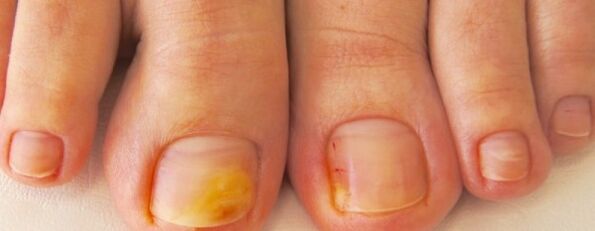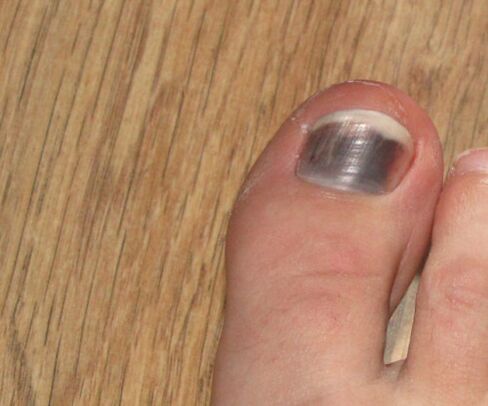Most people do not even know that the most frequent sweating of the feet and the accompanying unpleasant odor is one of the main signs of the development of a fungal disease. Toenail fungus, the symptoms of which do not appear immediately, can occur to any person who does not take care of himself even a little. This disease awaits almost everywhere, and more often in public places. The sad thing is that a fungal infection is quite insidious: it is treated for a long time and is not effective in 100% of cases, as it is characterized by relapses. To detect the fungus early and start treatment, you need to have an idea of how the nail fungus manifests.

The spread of a fungal disease
The disease is caused by the growth of parasitic fungi in the body. The best conditions for their emergence and subsequent spread are a warm environment at the same time as high humidity. Many are of the opinion that it is very easy to catch such an infection in water parks, baths, beauty salons.
But the statistics are completely different: you can get fungal infections even without leaving your home through common objects (bathroom, clothes, shoes, towels). However, this is true if at least one member of the household is a carrier of the fungus. And yet, what primarily affects the spread of the fungus? There are such basic aspects that cause infection from a fungal disease:
- Strong sweating;
- Diabetes;
- The problem of being overweight;
- If the nail is injured;
- Weak immunity.
To protect yourself in some way from fungal infection, you should use only personal hygiene products, do a complete shower and bath treatment, wear only your shoes, organize carpet washing as often as possible, etc. λπ. And if you have already noticed the first signs of toenail fungus, you should contact a dermatologist immediately!
Signs of a fungus, based on the causative agent of the disease

Signs of fungus on the toenails should be noticed in time. The effectiveness of complex treatment of a fungal infection is determined by the degree to which the causative agent of the disease has been correctly identified. This can be explained by the fact that there are many varieties of fungi and each species reacts to a specific group of drugs.
In most cases, the causative agents of the disease are:
- Mold;
- Dermatophytes?
- Yeast.
If the fungus started to grow due to yeast, then it is almost impossible to detect the disease overnight. The signs of a fungus on the feet under such conditions are as follows:
- The foot and the skin around the nail plate itch.
- The nail is peeling.
Yeast infection occurs only in 4-5% of cases. Very often, dermatophytes are the ones that affect the nail plate (94, 5%). This pathogen is of 3 types and the manifestation of each is very different:
- 1 type. There is a simultaneous defeat of the nail plate, the skin of the feet and the feet as a whole. Such a fungus moves easily on the nails and skin of the hands.
- 2 type. The disease affects only the nails of the thumb and little toe. It can also go in the folds between the fingers.
- 3 type. It is characterized by damage to the nail plate of the little finger and thumb, but the disease does not spread to the skin.
As for the mold, the causative agent in this case is the mold fungi. It is extremely rare. It is mainly found in patients with AIDS.
Other symptoms

Often, when the disease is just beginning to develop, there are no symptoms of toenail fungus. But if one pays close attention to one's feet, one will notice that round spots have started to appear on the nail plate and the nail itself loses its luster and becomes rough. Growing, a fungal disease affects the nail plate to a greater extent: its color will initially change, after which the nail is exfoliated, it can easily break. The color of the nail plate is determined by the type of pathogenic fungus.
Toenail fungus: symptoms (extra)
- The nail plate turns black.
- The nail takes on an unusual shape and its structure changes completely.
- The nails become very brittle.
- Plastic nail cuts under the skin.
- There is constant fatigue.
An abnormal appearance of the nail plate is a "bell" for a visit to a dermatologist and there will be confirmed or refuted the nail fungus, the symptoms of which you have noticed. If you constantly postpone going to the doctor, the disease will spread quickly to other areas. If you do not think about it, then there is nothing life threatening about this disease. But, apart from being a purely aesthetic problem and annoyance, a fungal infection is sometimes the cause of major complications. For this reason, the symptoms should not be ignored and the treatment of the disease should be started in time, as soon as it is established.
Doctor treating fungal diseases
It is realistic to detect an infection on your own, but only a doctor can confirm your assumptions. To make an accurate diagnosis, a dermatologist will recommend certain tests. To apply them, a piece of damaged nail plate or scraping of the peritoneal tissues is obtained.
Early detection of infection facilitates further treatment and eliminates the possibility of complications. If treatment is not started at the right time, this will ensure that the disease spreads to other organs and all fingernails / toenails.
Toenail fungus: a healing process
Treatment aimed at treating the fungus is prescribed by a dermatologist - it will all depend on how advanced the disease is, the type of fungus present in the body and other factors. Usually, if the fungus is just starting to grow, medicines are prescribed for external use. In more difficult situations, resort to intensive treatment.
By the way, it takes a long time. Therefore, it is in your best interest to see a doctor with the slightest suspicion of fungal infection! The symptoms of nail fungus should be recognized in advance. And the sooner the disease is detected, the faster the cure will be done!





























